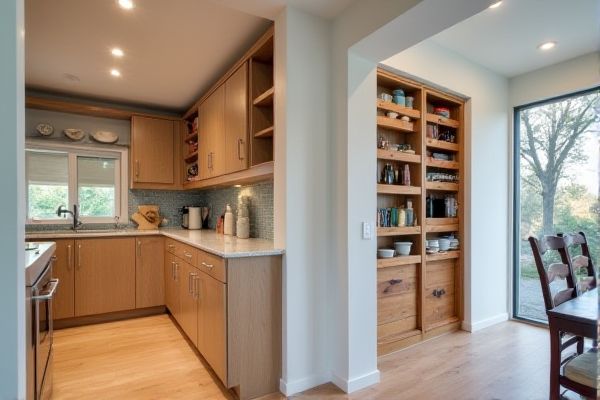
Choosing between a standalone pantry and an integrated kitchen pantry depends on your space, storage needs, and kitchen design preferences. Explore the pros and cons of each option to determine which pantry style best suits your home and elevates your kitchen organization. Read the rest of the article to make an informed choice for your culinary space.
Table of Comparison
| Feature | Standalone Pantry | Integrated Kitchen Pantry |
|---|---|---|
| Location | Separate room or closet | Built into kitchen cabinetry |
| Space Utilization | Maximizes storage space, can be larger | Optimizes kitchen layout, saves floor space |
| Accessibility | May require walking to another room | Quick access within kitchen workspace |
| Installation Cost | Higher due to separate construction | Lower; part of kitchen cabinetry |
| Design Flexibility | More customization options | Limited by kitchen design constraints |
| Maintenance | Independent cleaning and upkeep | Integrated with kitchen cleaning routine |
| Resale Value Impact | Significant if well-designed and spacious | Enhances kitchen appeal and functionality |
Introduction to Standalone and Integrated Kitchen Pantries
Standalone pantries offer flexible storage solutions as separate furniture pieces that can be moved or customized independently from the kitchen layout. Integrated kitchen pantries are built-in storage units seamlessly incorporated into cabinetry and walls, maximizing space efficiency and maintaining a cohesive kitchen design. Choosing between standalone and integrated pantries depends on kitchen size, design preferences, and storage needs.
Defining Standalone Pantries: Features and Benefits
Standalone pantries are separate storage units designed for kitchens, offering distinct features like movable shelves, customizable compartments, and increased storage capacity compared to integrated kitchen pantries. Their flexibility allows you to place them independently anywhere in your kitchen or adjacent space, providing easy access and organized storage without the constraints of existing cabinetry. This versatility benefits those looking to maximize space, improve kitchen organization, and maintain a clutter-free cooking environment.
Understanding Integrated Kitchen Pantries
Integrated kitchen pantries optimize storage by seamlessly blending with kitchen cabinetry, enhancing both accessibility and aesthetic appeal. Unlike standalone pantries, they maximize space efficiency by eliminating the need for additional furniture, contributing to a streamlined kitchen layout. Modern integrated pantries often feature customizable shelving, pull-out drawers, and built-in lighting to improve organization and usability.
Space Efficiency: Which Pantry Maximizes Storage?
An integrated kitchen pantry maximizes storage by seamlessly utilizing existing cabinetry and wall space, creating a streamlined and space-efficient design ideal for smaller kitchens. Standalone pantries provide flexible storage options and larger capacity but require additional floor space, which can limit room flow and kitchen layout. You can optimize storage efficiency by choosing an integrated pantry in compact kitchens, while standalone units suit larger areas needing expansive storage.
Design and Aesthetic Impact on Your Kitchen
Standalone pantries offer flexibility in placement and can serve as striking focal points with their distinct styles and finishes, enhancing the kitchen's overall character. Integrated kitchen pantries provide a seamless, built-in look that promotes a clean and streamlined aesthetic, maintaining cohesive cabinetry lines and maximizing space efficiency. Choosing between the two depends on desired visual effect and functional kitchen layout, balancing individuality against uniform design.
Installation and Maintenance Considerations
Standalone pantries offer flexible installation with minimal modifications, making them ideal for renters or those seeking easy relocation. Integrated kitchen pantries require professional installation and periodic maintenance to ensure hinges, shelves, and doors remain aligned and functional within the cabinetry. Your choice will impact long-term upkeep, as integrated units often demand more attention but provide a seamless kitchen aesthetic.
Flexibility and Adaptability for Changing Needs
Standalone pantries offer greater flexibility and adaptability, allowing you to move or reconfigure them as your storage needs evolve. Integrated kitchen pantries provide seamless design integration but may limit future modifications due to built-in cabinetry constraints. Choosing a standalone pantry supports dynamic kitchen layouts and easy adjustments for expanding or shifting storage requirements.
Cost Comparison: Standalone vs Integrated Pantries
Standalone pantries generally have a lower upfront cost due to simpler installation and modular designs, while integrated kitchen pantries require higher investment because they involve custom cabinetry and renovation work. Your choice impacts long-term value, as integrated pantries enhance kitchen aesthetics and increase home resale appeal despite the initial expense. Evaluating budget constraints against the functional and visual benefits of each pantry type will guide the most cost-effective decision.
Organization and Accessibility for Everyday Living
Standalone pantries offer flexible organization options with customizable shelves and bins, making it easy to arrange items based on your daily cooking habits. Integrated kitchen pantries maximize space efficiency, providing seamless accessibility within your kitchen workflow to quickly grab ingredients while preparing meals. Both designs improve everyday living by streamlining storage, but your choice depends on preferred accessibility and available space in your home.
Choosing the Right Pantry Solution for Your Home
Choosing the right pantry solution depends on your kitchen layout and storage needs, with standalone pantries offering flexible placement and increased capacity, ideal for larger kitchens or those seeking extra storage space. Integrated kitchen pantries seamlessly blend with cabinetry, maximizing space efficiency and maintaining a cohesive design, perfect for smaller kitchens or minimalist aesthetics. Evaluating your available space, storage requirements, and design preferences ensures you select a pantry solution that enhances functionality and complements your home's interior.
 homyna.com
homyna.com